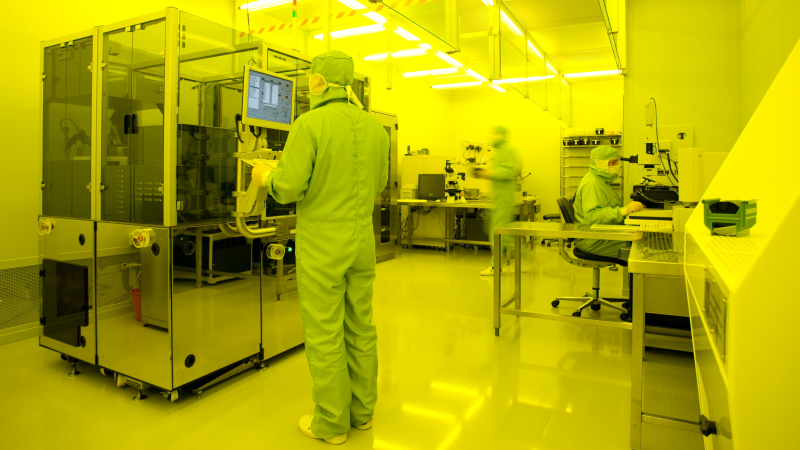We’ve covered the Tiny Tapeout project a few times on these pages, and while getting your digital IC design out there onto actual silicon for a low cost is super cool, it is still somewhat limited. Now, along comes the German FMD QNC project funding MPW (multi-project wafer) runs not in bog standard Silicon CMOS but Silicon-Germanium bipolar technology. And this is accessible to you and me, of course, provided you have the skills to design in this high-speed analog technology.
The design can be submitted via Github by cloning the IHP-Open-DesignLib repo, adding your design, and issuing a pull request. If your submission passes the correctness checks and is selected, it will be fabricated in-house by the IHP pilot line facility, which means it will take at least four months to complete. However, there are a few restrictions. The design must be open source, DRC complete (obviously!) and below a somewhat limiting two square millimetres. Bonus points for selecting your project can be had for good documentation and a unique quality, i.e., they shouldn’t have too many similar designs in the project archive. Also, you don’t get to keep the silicon samples, but you may rent them for up to two years for evaluation. In fact, anybody can rent them. Still, it’s a valuable service to trial a new technique or debug a design and a great way to learn and hone a craft that is difficult to get into by traditional means. Such projects would be an excellent source of verifiable CV experience points we reckon!
If you fancy getting your hands on your own silicon, but bipolar SiGe is a bit of a stretch, look no further than our guide to Tiny Tapeout. But don’t take our word for it—listen to the creator himself!
















So I design a chip but I don’t get to own or even keep the results?
I’ll stick with the openframe project. Their tools may still be buggy, but at least we own the fistful of chips that come out the other end, working or not….
Agreed. Renting the chip for two years seems a very strange setup.
I mean, I understand it from the “here is a sample of how this design came out” perspective. You could test out a working version of a design you were interested in. Like the old requirement of models submitted to the patent office. And if you want them made in bulk anyway, these prototypes don’t really matter.
But it doesn’t seem to be aimed at us.
I have some inside info on this. It’s because IHP is German taxpayer funded, and it’s their research department doing this (not the commercial side). For this reason, they are not allowed to give or sell chips. This is the best compromise the lawyers could come up with.
Also, I don’t think it’s such a bad limitation – for research most people only need a few chips for a short time and then they just sit on a shelf and gather dust.
Also, replying to NFM, both PDKs use the same fundamental tools (OpenROAD) so they’ll share the same bugs.
So it is a workaround to avoid giving German tax payers money away internationally!
But say that I submitted a chip for SDR (Software Defined Radio) with an basic ADC, one or more Gilbert cells (frequency mixers), and a few fixed filters and tracking filters. Not an amzing dynamic range (low number of bits per sample) but optimized for maximum sample rate (wide bandwidth) and the kind of frequency range that is possible with SIGE, who would retain ownership. I’m just picking this because it is generic enough on paper to be nothing special. But it is the kind of design that could easily be useful in many applications (for RX).
Maybe in 2 years you will be on to v2 anyway?
Oh no! Tape-out! I used to design RF modulators and demodulators using Temic’s SiGe process back in the 90s with time and frequency domain simulations (harmonic balance) run on HP workstations. I can’t tell you how many 60-80 hour weeks I used to work prepping designs for tape-out only to have the date moved at the last minute, starting another couple weeks of pre tape-out hell! I don’t miss it at all.
It’s a neat idea to have your open source chip designs made in the real world, and made available to interested parties. The contact is quite a normal rental contact which describes how you can rent and evaluate the chip. However, a fairly restrictive renting agreement for a chip made with open source designs seems a bit strange, and I would like to learn more about the process and reasoning. Selling the chips at cost, and requesting the evaluation results to be shared would be more appropriate, than renting the chip and demanding the results to be published. Non-commercial also feels more restrictive than necessary.
I understand the service without restrictions could be abused for cheap R&D projects, and the project doesn’t profit if all results are kept secret, but it’s all more restrictive and thus less accessible to join the project. If you have insights on the rental structure, beyond what’s in the git and readthedocs, please share.